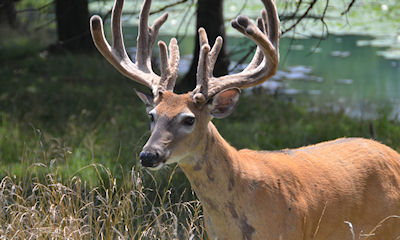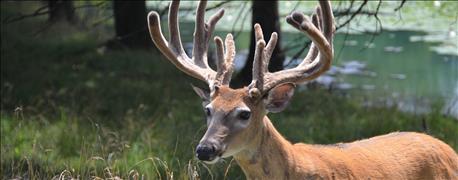September 19, 2016

A 3.5-year-old buck taken recently in Meridian Township is likely to be the eighth positive animal with Chronic Wasting Disease and the first discovered since March of this year.
The sample is currently being tested by the U.S. Department of Agriculture’s National Veterinary Services Laboratory in Ames, Iowa, to finalize confirmation.
The suspect deer was taken as part of the DNR’s CWD management program through targeted sharpshooting, which actively removes deer that are more likely to be affected with the disease in and around areas where previously identified CWD-positive animals had been detected.

Chronic wasting disease suspected in Ingham County deer
Since May 2015, the Michigan Department of Natural Resources has been actively conducting surveillance for chronic wasting disease (CWD). To date, more than 6,000 deer have been tested since the first positive was found.
“This latest suspect positive reinforces the notion that the disease is still occurring in Meridian Township and perhaps elsewhere,” says Chad Stewart, DNR deer specialist. “We are counting on hunters to bring their deer in for testing so we have a better understanding about the scope of the disease.”
Due to positive deer also detected in DeWitt and Watertown townships, the Core CWD Area has been expanded to now include 17 townships. This area, which is referred to as Deer Management Unit (DMU) 333, consists of Lansing, Meridian, Williamstown, Delhi, Alaiedon and Wheatfield townships in Ingham County; DeWitt, Bath, Watertown, Eagle, Westphalia, Riley, Olive and Victor townships in Clinton County; Woodhull Township in Shiawassee County; and Oneida and Delta townships in Eaton County. Hunters harvesting deer in these townships are required to submit the deer head for testing during business hours or check-station hours within 72 hours of harvest.
The CWD Management Zone also has expanded; it now includes Clinton, Eaton, Ingham, Ionia and Shiawassee counties. The expanded Management Zone has been renamed DMU 419. The price for an antlerless license in this zone has been decreased 40% to encourage hunters to harvest more deer and voluntarily have them checked.
There will be five check stations accepting deer for CWD testing within DMU 333. These check stations will be operating seven days a week (excluding major holidays). A complete map of check stations, including locations and hours of operation, is available at mi.gov/cwd.
Deer feeding and baiting is prohibited throughout the Core CWD Area and CWD Management Zone.
CWD is a fatal neurological disease that affects white-tailed deer, mule deer, elk and moose. It is caused by the transmission of infectious, self-multiplying proteins (prions) contained in saliva and other body fluids of infected animals. Susceptible animals can acquire CWD by direct exposure to these fluids, from environments contaminated with these fluids or the carcass of a diseased animal.
Some chronically CWD-infected animals will display abnormal behaviors, progressive weight loss and physical debilitation; however, deer can be infected for many years without showing internal or external symptoms. There is no cure; once a deer is infected with CWD, it will die.
To date, there is no evidence that CWD presents any risk to non-cervids, including humans, either through contact with an infected animal or from handling venison. However, as a precaution, the U.S. Centers for Disease Control and the World Health Organization recommend that infected animals not be consumed as food by either humans or domestic animals.
Anyone interested in learning more about how Michigan is managing CWD can view the new 2015-2016 Michigan Chronic Wasting Disease Management and Surveillance Report. Additionally, the DNR is holding a Facebook Live event Sept. 20 at 12 p.m. EDT to answer questions about CWD, CWD management and the impacts the disease could have on the future of Michigan’s deer. Follow the Michigan DNR’s Facebook page for more details.
Source: MDNR
You May Also Like




